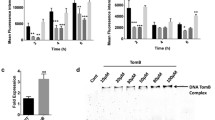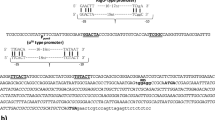Abstract
Toxin-antitoxin (TA) systems are small genetic elements composed of a toxin gene and its cognate antitoxin that are important for plasmid stabilization (plasmid-encoded) and bacterial virulence (chromosome-encoded). These systems are also related to biofilm and persister cell formations. Pseudomonas aeruginosa is an antibiotic-resistant human pathogen that produces virulence factors modulated by quorum sensing (QS) and can form biofilms. The type II PumAB TA system of pUM505, isolated from a clinical strain of P. aeruginosa, confers plasmid stability. Additionally, the PumA toxin increases P. aeruginosa virulence and is neutralized by the PumB antitoxin. In this study, we determined whether virulence conferred by PumA toxin is regulated by QS. The pumA gene was transferred to P. aeruginosa lasI/rhlI, a mutant strain in the LasI and RhlI QS systems, to analyze the effect on virulence of the transformants. pumA transfer did not increase bacterial virulence in lettuce and Caenorhabditis elegans, suggesting that the virulence conferred by PumA requires QS modulation. pumA mRNA levels drastically decreased in the P. aeruginosa lasI/rhlI (pUC_pumA) strain, suggesting positive regulation of pumA gene expression by QS. Supplementation of the growth medium of P. aeruginosa lasI/rhlI (pUC_pumA) with C4-AHL and 3-oxo-C12-AHL autoinducers increased pumA mRNA levels and restored bacterial virulence, suggesting that both autoinducers complemented the mutations and positively regulated the toxic effects of PumA. This strengthened the hypothesis that QS regulates bacterial virulence conferred by the PumA toxin. Thus, this report establishes an important function of QS in the virulence conferred by plasmid-encoded TA systems in bacterial pathogens.





Similar content being viewed by others
References
Pendleton JN, Gorman SP, Gilmore BF (2013) Clinical relevance of the ESKAPE pathogens. Expert Rev Anti Infect Ther 11:297–308
Quick J, Cumley N, Wearn CM, Niebel N, Constantinidou C, Thomas CM, Palle M, Moiemen NS, Bamford A, Oppenheim B, Loman NJ (2014) Seeking the source of Pseudomonas aeruginosa infections in a recently opened hospital: an observational study using whole-genome sequencing. BMJ Open 4(11):e006278
Rahme LG, Ausubel FM, Cao H, Drenkard E, Goumnerov BC, Lau GW, Mahajan-Miklos S, Plotnikova J, Tan MW, Tsongalis J, Walendziewicz CL, Tompkins RG (2000) Plants and animals share functionally common bacterial virulence factors. Proc Natl Acad Sci USA 97:8815–8821
Lee J, Zhang L (2015) The hierarchy quorum sensing network in Pseudomonas aeruginosa. Protein Cell 6(1):26–41
Antunes LCM, Ferreira RBR, Buckner MMC, Finlay BB (2010) Quorum sensing in bacterial virulence. Microbiology 156:2271–2282
Leplae R, Geeraerts D, Hallez R, Guglielmini J, Drèze P, Van Melderen L (2011) Diversity of bacterial type II toxin-antitoxin systems: a comprehensive search and functional analysis of novel families. Nucleic Acids Res 39:5513–5525
Page R, Peti W (2016) Toxin-antitoxin systems in bacterial growth arrest and persistence. Nat Chem Biol 12:208–214
Fernández-García L, Blasco L, Lopez M, Bou G, García-Contreras R, Wood T, Tomas M (2016) Toxin-antitoxin systems in clinical pathogens. Toxins 8(7):227
Yamaguchi Y, Park JH, Inouye M (2011) Toxin-antitoxin systems in bacteria and archaea. Annu Rev Genet 45:61–79
Unterholzner SJ, Poppenberger B, Rozhon W (2013) Toxin-antitoxin systems: biology, identification, and application. Mob Genet Elem 1(3):e26219
De la Cruz MA, Zhao W, Farenc C, Giménez G, Raoult D, Cambillau C, Gorvel JP, Méresse S (2013) A toxin-antitoxin module of Salmonella promotes virulence in mice. PLOS Pathog 9(12):e1003827
Wang X, Wood TK (2011) Toxin-antitoxin systems influence biofilm and persister cell formation and the general stress response. Appl Environ Microbiol 77(16):5577–5583
Hemati S, Azizi-Jalilian F, Pakzad I, Taherikalani M, Maleki A, Karimi S, Monjezei A, Mahdavi Z, Reza Fadavi M, Sayehmiri K, Sadeghifard N (2014) The correlation between the presence of quorum sensing, toxin-antitoxin system genes and MIC values with ability of biofilm formation in clinical isolates of Pseudomonas aeruginosa. Iran J Microbiol 6(3):133–139
Hernández-Ramírez KC, Chávez-Jacobo VM, Valle-Maldonado MI, Patiño-Medina JA, Díaz-Pérez SP, Jácome-Galarza IE, Ortiz-Alvarado R, Meza-Carmen V, Ramírez-Díaz MI (2017) Plasmid pUM505 encodes a Toxin-Antitoxin system conferring plasmid stability and increased Pseudomonas aeruginosa virulence. Microb Pathog 112:259–268
Green MR, Sambrook J (2012) Molecular cloning: a laboratory manual, 4th edn. Cold Spring Harbor Laboratory, Cold Spring Harbor, NY
Pfaffl MW (2001) A new mathematical model for relative quantification in real-time RT-PCR. Nucleic Acids Res 29:2000–2007
Rodríguez-Andrade E, Hernández-Ramírez KC, Díaz-Peréz SP, Díaz-Magaña A, Chávez-Moctezuma MP, Meza-Carmen V, Ortíz-Alvarado R, Cervantes C, Ramírez-Díaz MI (2016) Genes from pUM505 plasmid contribute to Pseudomonas aeruginosa virulence. Antonie Van Leeuwenhoek 109:389–396
Battle SE, Meyer F, Rello J, Kung VL, Hauser AR (2008) Hybrid pathogenicity island PAGI-5 contributes to the highly virulent phenotype of a Pseudomonas aeruginosa isolate in mammals. J Bacteriol 190:7130–7140
Dong X, Mindrinos M, Davis KR, Ausubel FM (1991) Induction of Arabidopsis defense genes by virulent and avirulent Pseudomonas syringae strains and by a cloned virulence gene. Plant Cell 3:61–72
Brenner S (1974) The genetics of Caenorhabditis elegans. Genetics 77:71–94
Stiernagle T (2006) Maintenance of C. elegans. Worm Book, pp. 1–11.
Pearson JP, Gray KM, Passador L, Tucker KD, Eberhard A, Iglewski BH, Greenberg EP (1994) Structure of the autoinducer required for expression of Pseudomonas aeruginosa virulence genes. Proc Natl Acad Sci USA 91:197–201
Erdönmez D, Rad AY, Aksöz N (2017) Quorum sensing molecules production by nosocomial and soil isolates Acinetobacter baumannii. Arch Microbiol 199(10):1325–1334
Boşgelmez-Tinaz G, Ulusoy S, Aridoğan B, Eroğlu F, Kaya S (2005) N-butanoyl-L-homoserine lactone (BHL) deficient Pseudomonas aeruginosa isolates from an intensive care unit. Microbiol Res 160(4):399–403
Ramírez-Díaz MI, Díaz-Magaña A, Meza-Carmen V, Johnstone L, Cervantes C, Rensing C (2011) Nucleotide sequence of Pseudomonas aeruginosa conjugative plasmid pUM505 containing virulence and heavy-metal resistance genes. Plasmid 66(1):7–18
Otsuka Y (2016) Prokaryotic toxin-antitoxin systems: novel regulations of the toxins. Curr Genet 62(2):379–382
Wen Y, Behiels E, Devreese B (2014) Toxin-Antitoxin systems: Their role in persistence, biofilm formation, and pathogenicity. Pathog Dis 70:240–249
Kedzierska B, Hayes F (2016) Emerging roles of toxin–antitoxin modules in bacterial pathogenesis. Molecules 21:790
Lazazzera BA (2000) Quorum sensing and starvation: signals for entry into stationary phase. Curr Opin Microbiol 3(2):177–182
Whitehead NA, Barnard AM, Slater H, Simpson NJ, Salmond GP (2001) Quorum-sensing in gram-negative bacteria. FEMS Microbiol Rev 25:365–404
Ng WL, Bassler BL (2009) Bacterial quorum-sensing network architectures. Annu Rev Genet 43:197–222
Deng Y, Wu J, Tao F, Zhang LH (2011) Listening to a new language: DSF-based quorum sensing in gram-negative bacteria. Chem Rev 111:160–173
Pereira CS, Thompson JA, Xavier KB (2013) AI-2-mediated signaling in bacteria. FEMS Microbiol Rev 37:156–181
Schuster M, Lostroh CP, Ogi T, Greenberg EP (2003) Identification, timing, and signal specificity of Pseudomonas aeruginosa quorum- controlled genes: a transcriptome analysis. J Bacteriol 185:2066–2079
Schuster M, Greenberg EP (2006) A network of networks: quorumsensing gene regulation in Pseudomonas aeruginosa. Int J Med Microbiol 296:73–81
Acknowledgements
This work was supported by grants from Coordinación de la Investigación Científica (UMSNH; 2.6 and 2.35). KCH-R and MIV-M were supported by postgraduate fellowships from CONACYT.
Author information
Authors and Affiliations
Contributions
KC H-R, B V-A and MI V-M, data acquisition, analysis, and data interpretation, LF R-H and V M-C, reagents, analysis; V M-C data interpretation, and critical revision of the article for intellectual content; MI R-D, conception and design of the work, data analysis and interpretation, and drafting of the article.
Corresponding author
Ethics declarations
Conflicts of interest
The authors declare that they have no conflict of interest.
Additional information
Publisher's Note
Springer Nature remains neutral with regard to jurisdictional claims in published maps and institutional affiliations.
Electronic supplementary material
Below is the link to the electronic supplementary material.
Rights and permissions
About this article
Cite this article
Hernández-Ramírez, K.C., Valerio-Arellano, B., Valle-Maldonado, M.I. et al. Virulence Conferred by PumA Toxin from the Plasmid-Encoded PumAB Toxin-Antitoxin System is Regulated by Quorum System. Curr Microbiol 77, 2535–2543 (2020). https://doi.org/10.1007/s00284-020-02083-3
Received:
Accepted:
Published:
Issue Date:
DOI: https://doi.org/10.1007/s00284-020-02083-3




